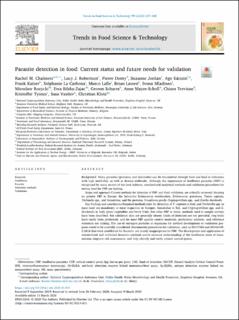| dc.description.abstract | Background:
Many parasites (protozoa and helminths) can be transmitted through food and lead to infections with high morbidity, as well as disease outbreaks. Although the importance of foodborne parasites (FBP) is recognised by many sectors of the food industry, standardized analytical methods and validation procedures for testing food for FBP are lacking.
Scope and approach:Current methods for detection of FBP, and their validation, are critically reviewed, focusing on priority FBP in Europe: the helminths Echinococcus multilocularis, Echinococcus granulosus, Taenia saginata, Trichinella spp., and Anisakidae, and the protozoa Toxoplasma gondii, Cryptosporidium spp., and Giardia duodenalis.
Key findings and conclusions:Standard methods exist for detection of T. saginata in beef, and Trichinella spp. In meat (and are mandatory at meat inspection in Europe), Anisakidae in fish, and Cryptosporidium spp. and G. duodenalis in leafy green vegetables and berry fruits. For other FBP or foods, methods used in sample surveys have been described, but validation data are generally absent; limits of detection are not provided, ring trials have rarely been performed, and for most FBP quality control materials, proficiency schemes, and reference standards are lacking. The use of surrogate particles or organisms for method development or validation purposes needs to be carefully considered. Documented procedures for validation, such as ISO17468 and ISO16140-2:2016 that were established for bacteria, are mostly inappropriate for FBP. The development and application of standardized and validated detection methods would enhance understanding of the foodborne route of transmission, improve risk assessments, and help identify and verify critical control points. | en_US |

